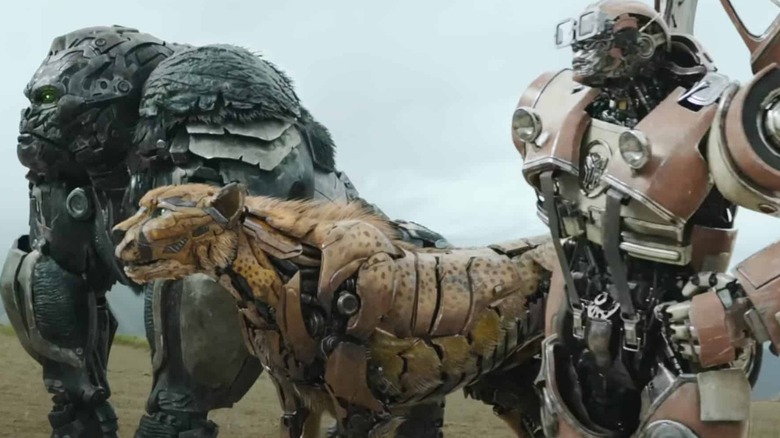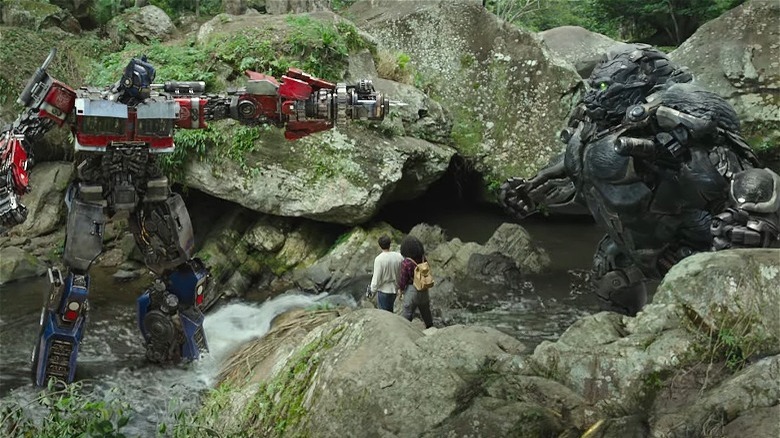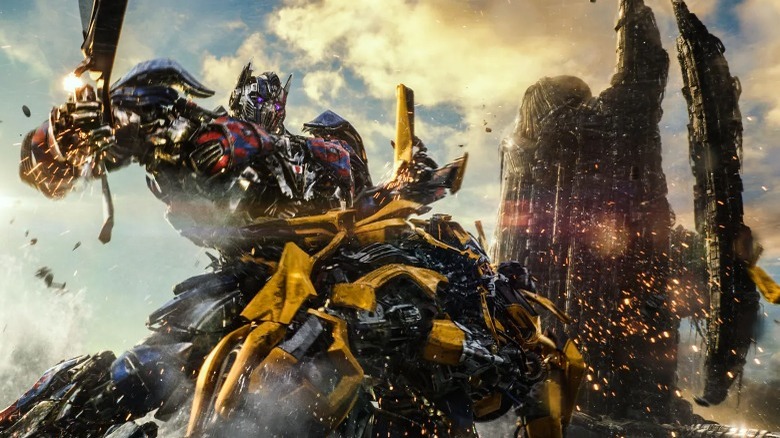How Transformers: Rise Of Beasts Composer Jongnic Bontemps Brought His Own Sound To The Universe
"Transformers: Rise of the Beasts" brings beloved animated characters to live-action for the first time, namely the Maximals from the 1996 "Beast Wars: Transformers" series. This is one of the many ways the new entry in the long-standing franchise aims to up the ante, and with so many parties in the mix, the fate of Earth, along with the Transformers' home planet Cybertron, is in imminent danger. Following the basic story beats of previous installments helmed by Michael Bay, "Rise of the Beasts" introduces Noah (Anthony Ramos), one of the human characters who must rise to the occasion and help the Autobots and the Maximals win a tense fight against the film's antagonists.
With a story that has widened its scope considerably, "Rise of the Beasts" demands an equally fitting and exciting soundtrack to enhance the wonders it has to offer. Enter composer Jongnic Bontemps, best known for his work on "Creed II," who ended up creating a unique sound for a film rooted in decades of "Transformers" lore while keeping character specificity in mind. Bontemps spoke to ScreenRant about the pressure that came with working on such a huge franchise, and the need to balance between a sound that felt fresh and one that also fit the "Transformers" cinematic universe at large.
As a lot of careful research went into the creation of the film's soundtrack, Bontemps worked steadily toward creating a sound of his own, all the while collaborating closely with director Steven Caple Jr. As Bontemps and Caple Jr. previously worked together on "Creed II," there was a seamless synergy between the two during the process, with the aim being the creation of "a language between the composer and the director, where [they could] talk about a thing and be able to understand each other."
Putting the pieces together
In the interview, Bontemps talks about his love for the franchise since a young age, which helped him channel the right kind of feel to the new soundtrack that was a mix of franchise legacy and what's to come. Bontemps also had to ensure that the sound had a distinct '90s feel to it, as the events of "Rise of the Beasts" take place in 1994, way before whatever went down in the Michael Bay movies. The composer had to take these several strands of location-specificity and franchise identity into consideration:
"Having Steve's Jablonsky's scores and listening to those gave me a feeling of, 'Okay, this is the world that the music needs to fit in.' But, also, the fact that this movie starts after Bumblebee...before the timeline of the Bay movies meant that I was able to think about, 'Well, how would we want to have the score reflect the '90s, reflect Brooklyn, reflect Peru and bring those elements into what we would call a hybrid orchestral score that's a big orchestra with a lot of electronic or synth elements?' Those are the big thoughts that I had when I was approaching the score."
Moreover, as Bontemps was also well-versed with "Beast Wars" lore, it helped create appropriate sonal backdrops for legacy characters such as Optimus Primal and the remaining Maximals. As the Maximals had never appeared in live-action before, this was a chance to do something fresh and create a sound that felt inspiring and heroic, just like the new faction of Transformers who are introduced.
As for location-centric themes, Bontemps dived into his personal experiences in Brooklyn to define the sonic atmosphere of the city in the '90s, using local hip-hop with "syncopated rhythms" to capture the lively aura of the location.
A snazzy, rousing orchestra
A mix of various musical styles was used to create a hybrid sonic identity for a film that jumps locations midway — the final stop for Noah and the Autobots, Peru, called for the incorporation of local musical traditions that were authentic to the place. Flutes were used, along with the guitarrón and charango to heighten the tense nature of the humans' search for the second part of the Transwarp Key situated deep beneath temple ruins.
As for the soaring, climactic pieces, Bontemps explained the process of simulating an orchestra in the demo format and then adding the finishing touches to evoke an idea of what the final piece would sound like:
"So I would write the music that simulated the orchestra, I would add in the 808 [The Roland TR-808 Rhythm Composer, a drum machine], I would add in my synth, and this way we would then have something to talk about...Once that's done, then the job of getting that out of my computer into the downstream process for recording began. That means we'd have to create sheet music for all the musicians to play..."
In essence, the soundtrack creation process for "Rise of the Beasts" was pretty challenging for Bontemps, but given his incredible talent and his innate knowledge of the franchise, he was able to create something truly fitting and interesting.
"Transformers: Rise of the Beasts" is now playing in theaters.


